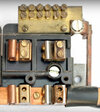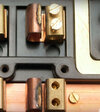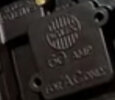Yes the first fuse carrier was often higher rated

note the different colour of the spring, however this was because of the flash caused by removing the fuse which could cause this

with a MCB it is not withdrawn while switched on, so not really a problem, and yes the main isolator was rated 60 amp,

however if the DNO fuse is over 60 amp, then really the DNO at fault, not the owner, it is very unlikely that an old Wylex fuse box has been fitted after a 100 amp fuse is fitted, the DNO should never fit a 80 or 100 amp fuse where the isolator is 60 amp.
The situation with a 63 amp RCD feeding over 63 amp of MCB's is rather different. Where two RCD's are fed from a single DNO fuse it was felt that diversity could be taken into account. I know thoughts on this practice have changed, but the question as I keep on saying is not does it comply with BS 7671 that went when code 4 was removed, but is it dangerous or perpetually dangerous?
As again said many times 230 volt is always perpetually dangerous, so it is a bit of a daft question, however if we accept that post war installations were not perpetually dangerous when installed following the IEE/IET regulations, then the question is with any code C2 what has changed since the install?
It may well be that bonding in bathroom no longer exists due to use of plastic pipe, or cables have degraded, it is also possible it never did comply, my father had wall lights in the hall since the house was built in 1954, the rules at that time it seems were.
13th Edition said:
403 The application of Regulation 401 (iv) which exempts from the requirement of earthing metal which is so isolated that it is not liable to come into contact with live parts or with earthed metal, shall be restricted to the apparatus detailed in the following \clauses (i)-(ix):
(i) Short isolated lengths of conduit used for mechanical protection of tough-rubber- or p.v.c. -sheathed wiring.
(ii)Short unexposed isolated lengths of metal conduit used for the mechanical protection of cleated wiring where it passes through floors, walls, partitions or ceilings.
(iii)Short isolated lengths of catenary wire used with tough-rubber-sheathed or p.v.c.-sheather wiring systems, if screened by non-conducting material.
(vi) Lamp-caps.
(vii) Small parts such as screws or nameplates isolated by insulating material.
(viii) Metal chains for the suspension of lighting fittings, not in contact with flexible cord of the twisted type.
(ix) Lighting fittings using filament lamps installed in a room having a non-conducting floor, mounted at such a height that they cannot readily be touched and are out of reach of earthed metal.
Note the "mounted at such a height that they cannot readily be touched" with wall lights this was not the case, however it was wired when 12th edition was in force, don't know what that said, but we were suppose to have a PIR/EICR done every 10 years, so since code 4 was at that time still used, he should have been well aware many years ago of the 1966 changes in the regulations.
However only a few years ago the electrical safety council still published a photo of the old Wylex fuse box saying how they were still serviceable.
I know with my dad's house, it lost it's earth, it did have one, as I ruptured the fuse as a boy when I in error shorted line to earth, but some 40 years latter no sign of there ever being one. As to if originally used the water supply don't know, and the rubber wiring was in a state, he would not allow me to rewire the house, he said I could do it when he was gone.
When I came to do it, needed speed, mother had gone into hospital and wanted it done and dusted before her return. So used a scheme member firm mainly to ensure speed, but only just completed in the 12 weeks I had, which makes the 28 days allowed by the new landlord laws laughable.
As to correct procedure if the property fails, not sure, does one simply tell the tenants sorry it has failed the EICR you will have to leave until I have fixed the problems?
In the last month I have seen the problems, it was a caravan which it seems had been parked close to a hall of residence for years, and the owner would visit a few times a year, a blind eye was turned, until she sold it to a couple of guys who were going to use it 365 days a year, no longer could a blind eye be turned, TN-C-S supply, too close for building regs etc etc. The new guys were told it would need to be moved, tyres were rotten, corner jack were sized solid, there was no way that caravan was moving anywhere other than a scrap yard.
The problem was they should have never turned the blind eye, they should have told the previous owner it needed to go years ago. The same with things like EICR's, there is a tendency to turn a blind eye when you know only option is to stop renting it out for around 3 months to get the house done up.




